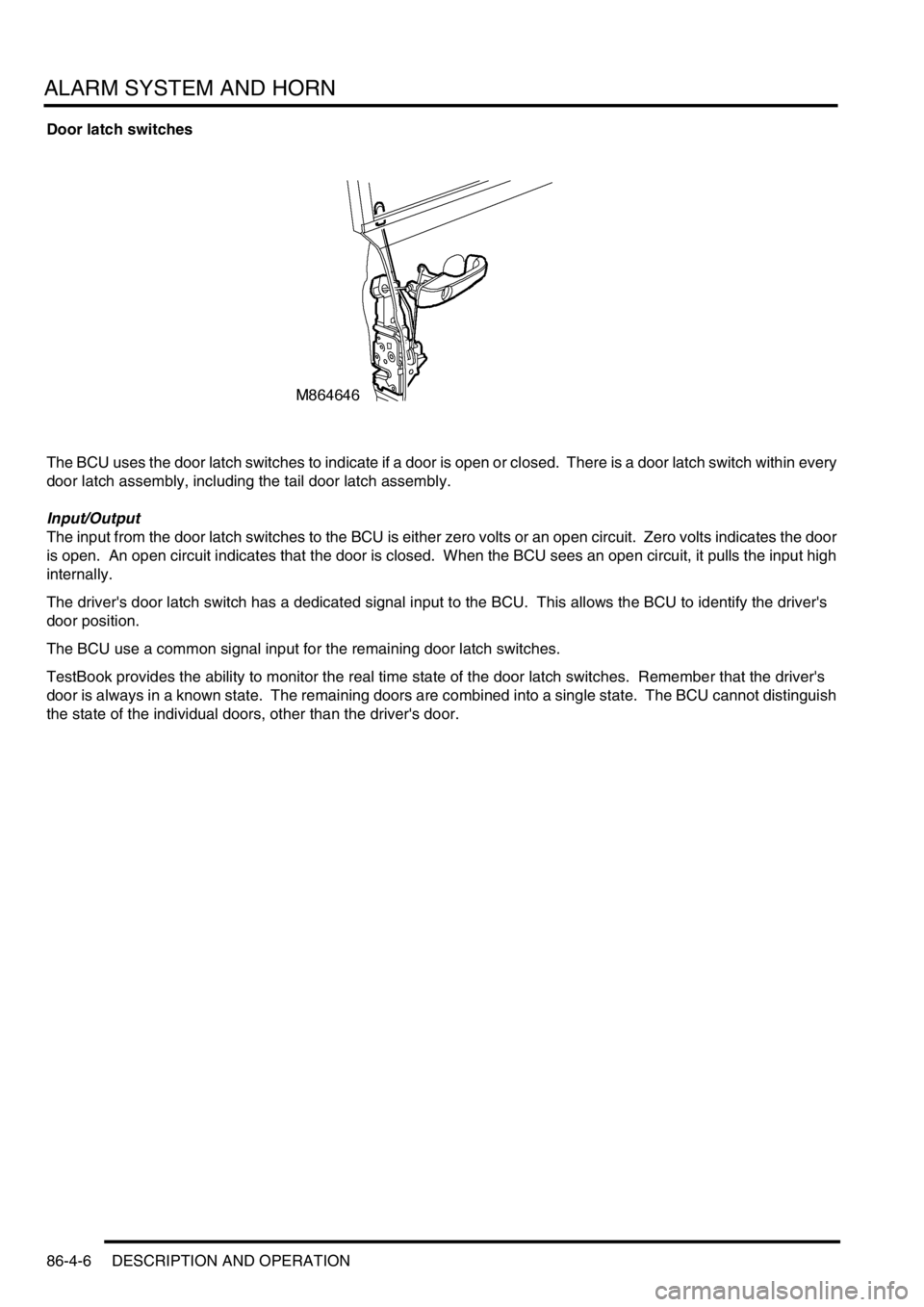Page 1325 of 1529
ALARM SYSTEM AND HORN
86-4-2 DESCRIPTION AND OPERATION
Alarm system component layout
RHD shown, LHD similar
Page 1326 of 1529
ALARM SYSTEM AND HORN
DESCRIPTION AND OPERATION 86-4-3
1Theft deterrent LED
2Receiver
3Volumetric sensors
4Central door locking switch
5Body Control Unit (BCU)
6Bonnet activated alarm switch
7Vehicle horn
8Alarm sounder
9Fuel cut off switch
10Fuel flap release switch
11Door latch switches, drivers door key lock/
unlock switches
12Battery Backed Up Sounder (BBUS)
13Passive remobilisation exciter coil
Page 1327 of 1529
ALARM SYSTEM AND HORN
86-4-4 DESCRIPTION AND OPERATION
Alarm system block diagram
1Body Control Unit (BCU)
2Remote handset
3Receiver
4Fuel cut off switch
5Ignition switch
6Central door locking switch
7Volumetric sensors
8Bonnet activated alarm switch
9Drivers door key lock/unlock switches
10Door latch switches 11Fuel flap release switch
12Intelligent Driver Module (IDM)
13Battery Backed Up Sounder (BBUS)
14Alarm sounder
15Vehicle horns
16Direction indicators
17Door lock actuators
18Engine Control Module (ECM)
19Starter motor
Page 1328 of 1529

ALARM SYSTEM AND HORN
DESCRIPTION AND OPERATION 86-4-5
Description
General
The anti-theft system deters the theft of the vehicle with both active and passive systems. The active systems monitor
the vehicle perimeter and, in some markets the vehicle interior, for intrusion. If the system detects intrusion, an alarm
sounds. The passive systems include a vehicle immobiliser as well as protection against intrusion through super
locking the doors. The vehicle is immobilised whenever the ignition key is removed from the ignition switch. Super
locking prevents the interior door handles from opening the doors. In addition, there are many features and functions
that enhance system operation.
It is possible to perform the various functions associated with the anti-theft system remotely. To accomplish this, the
handset generates a radio frequency when the lock button or unlock button is depressed. This signal is transmitted
to the Body Control Unit (BCU) via a receiver located in front of rear sunroof beneath the headlining. Precise alignment
of the handset to the receiver is not necessary. The approximate operating range between the handset and the
receiver is 10 metres (33 feet).
It is important to understand the configuration of the system on each particular vehicle. There are many
different combinations of features with dedicated operating modes. System configuration for each vehicle
can be determined using TestBook.
The anti-theft system is controlled centrally by the BCU, which is located below and behind the passenger glovebox.
A serial communication link communicates between the Intelligent Driver Module (IDM) located within the fusebox,
the BCU and the LED located in the instrument panel.
The state of the alarm is stored in the BCU. If the battery is disconnected while the alarm is armed, the alarm will be
triggered when the battery is reconnected.
NOTE: Disconnecting the battery while the alarm is armed triggers the alarm. Always disarm the alarm system before
disconnecting the battery.
The BCU also receives inputs from the following components:
lIgnition key in sensor.
lIgnition switch.
lFuel cut off switch.
lFuel flap release switch.
The BCU also interacts with the following components:
lStarter relay.
lVehicle horns.
lDirection indicators.
lFuel flap release actuator.
lCourtesy lamps.
Page 1329 of 1529

ALARM SYSTEM AND HORN
86-4-6 DESCRIPTION AND OPERATION
Door latch switches
The BCU uses the door latch switches to indicate if a door is open or closed. There is a door latch switch within every
door latch assembly, including the tail door latch assembly.
Input/Output
The input from the door latch switches to the BCU is either zero volts or an open circuit. Zero volts indicates the door
is open. An open circuit indicates that the door is closed. When the BCU sees an open circuit, it pulls the input high
internally.
The driver's door latch switch has a dedicated signal input to the BCU. This allows the BCU to identify the driver's
door position.
The BCU use a common signal input for the remaining door latch switches.
TestBook provides the ability to monitor the real time state of the door latch switches. Remember that the driver's
door is always in a known state. The remaining doors are combined into a single state. The BCU cannot distinguish
the state of the individual doors, other than the driver's door.
Page 1330 of 1529
ALARM SYSTEM AND HORN
DESCRIPTION AND OPERATION 86-4-7
Driver's door key lock/unlock switches
The BCU uses the driver's door key lock/unlock switches to activate and deactivate the alarm system. Two separate
switches are incorporated into the key lock of the driver's door.
Input/Output
The input from the driver's door key lock/unlock switches to the BCU is either zero volts or an open circuit. Zero volts
indicates the key lock is in the lock or unlock position. An open circuit indicates the key lock is in the centre position.
When the BCU senses an open circuit, it pulls the input high internally.
The driver's door key lock /unlock switches have a dedicated signal input to the BCU. This allows the BCU to identify
the lock/unlock position.
TestBook provides the ability to monitor the real time state of the driver's door key lock/unlock switches.
Page 1331 of 1529
ALARM SYSTEM AND HORN
86-4-8 DESCRIPTION AND OPERATION
Door lock actuators
The door lock actuators are D type latches. The door locks allow the vehicle to be locked/unlocked and super locked
to prevent access to the vehicle via the interior door handles.
Input/Output
The driver's door lock actuator has a dedicated 12 volts power supply from the passenger compartment fuse box to
energise the locking action of the door lock actuator. The passenger and rear door lock actuators share a 12 volts
power supply from the passenger compartment fuse box to energise the locking action of the door lock actuator.
To perform the super locking action all the door lock actuators receive a 12 volts power supply from the passenger
compartment fuse box.
To perform the unlocking action for all the doors, a 12 volts power supply from the passenger compartment fuse box
is supplied to the door lock actuators.
Page 1332 of 1529
ALARM SYSTEM AND HORN
DESCRIPTION AND OPERATION 86-4-9
Bonnet switch
The BCU uses a plunger type switch to determine if the bonnet has been forcibly opened when the alarm has been
set. The switch is located under the bonnet on the left hand side of the vehicle when viewed from the rear.
Input/Output
When the bonnet is closed the bonnet activated alarm switch is in an open condition and the input to the BCU is more
than 6 volts, in which case the BCU pulls the input high internally. When the bonnet is open the bonnet activated alarm
switch is closed and the input to the BCU is less than 2 volts.
The bonnet activated alarm switch has a dedicated signal input to the BCU. This allows the BCU to identify the
position of the bonnet.
TestBook provides the ability to monitor the real time state of the switch.